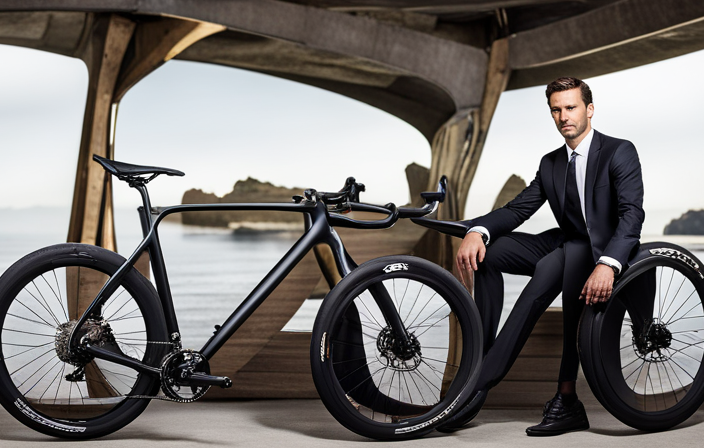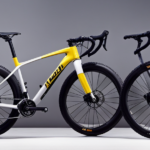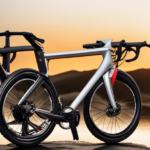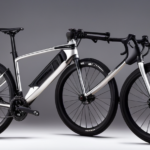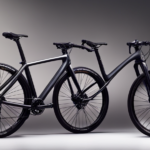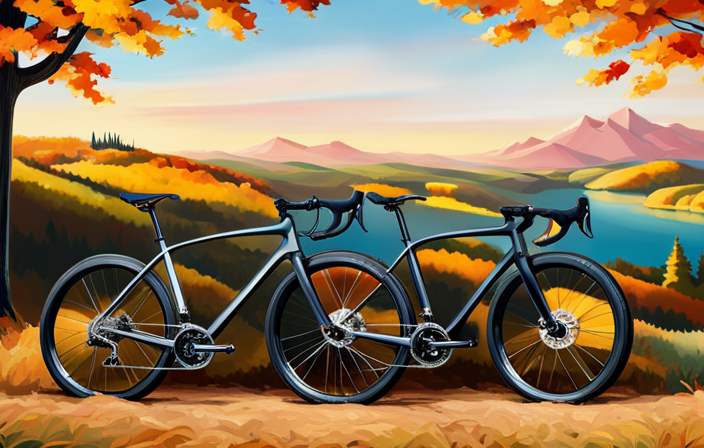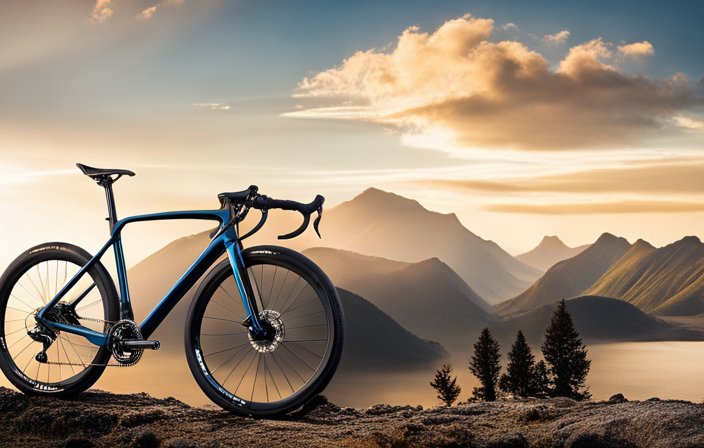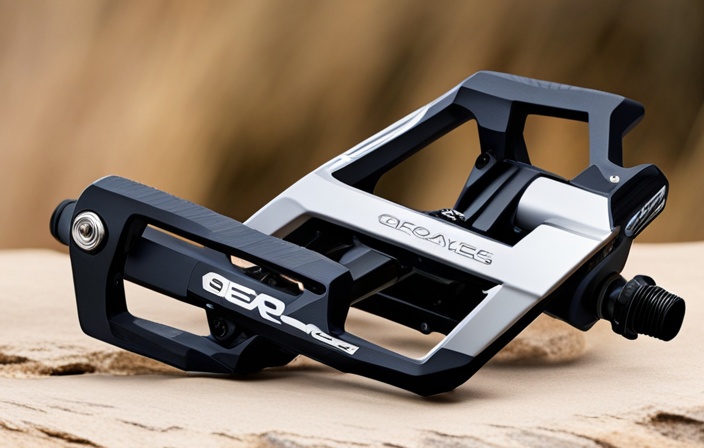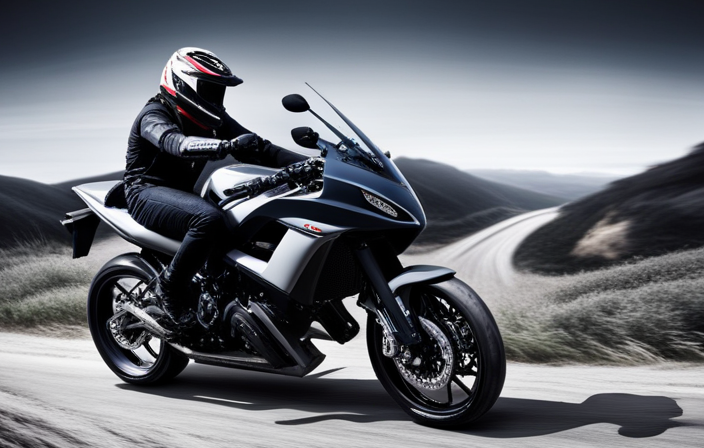While riding through the challenging terrain, the gravel beneath my tires crunches as I move forward on my reliable gravel bike. The question that remains at the forefront of my mind is: what is the optimal wheel size for this adventurous journey?
In this article, we will explore the various wheel options available and delve into the benefits of 650b, 700c, and 26-inch wheels.
With a focus on bike fit and accessories, we’ll help you choose the perfect wheel size for your gravel biking escapades.
Key Takeaways
- Gravel biking requires a reliable gravel bike with clearance for wider tires and disc brakes.
- Different wheel sizes, such as 700c, 650b, and 27.5′, offer various benefits and drawbacks depending on the terrain and riding style.
- 650b wheels provide better control and comfort on uneven terrain, with increased maneuverability and tire volume.
- It is important to consider the type of terrain, personal skill level, and preferences when selecting the appropriate wheel size for a gravel bike.
Overview of Gravel Biking
If you’re looking to get into gravel biking, it’s important to understand the basics. Gravel biking is a thrilling and adventurous sport that combines elements of road cycling and mountain biking. It involves riding on unpaved roads, gravel paths, and even some off-road trails.
One of the best things about gravel biking is the variety of events available for riders of all skill levels. From casual rides to challenging races, there’s something for everyone.
To start your gravel biking journey, it’s essential to have the right gear. A reliable gravel bike is crucial for navigating different terrains with ease. When choosing a gravel bike, make sure it has clearance for wider tires and disc brakes for better stopping power. Additionally, consider getting a bike with multiple mounting points for carrying extra gear like water bottles or bikepacking bags.
Understanding wheel size options is another crucial aspect of gravel biking. The most common wheel sizes are 700c and 650b. The 700c wheels provide excellent speed on smoother surfaces while still performing well on rougher terrain. On the other hand, 650b wheels offer increased traction and stability due to their wider tires.
In conclusion, if you’re interested in exploring the world of gravel biking, understanding the basics and having the right gear are key factors to consider. By participating in various gravel bike events and following gear recommendations, you’ll be well-prepared for exciting adventures on your new two-wheeled companion.
Understanding Wheel Size Options
When considering wheel options for a gravel bike, it’s important to understand the different size choices available. The right wheel size can greatly impact your performance and comfort while riding on gravel terrain.
Here is a comparison of different wheel sizes commonly used in gravel biking:
-
700c: This is the standard wheel size for most road bikes. It offers excellent rolling efficiency and speed on smooth surfaces. However, it may lack traction and stability on rougher gravel roads.
-
650b: These wheels have a smaller diameter than 700c, but they provide better control and comfort on uneven terrain. They offer increased traction and more forgiveness over bumps, making them popular among gravel enthusiasts.
-
27.5′: Similar to the 650b wheels, these larger diameter wheels provide improved stability and grip compared to 700c wheels. They are suitable for riders who prioritize confidence-inspiring handling over maximum speed.
-
29′: These larger wheels excel at maintaining momentum on flat or rolling terrain but may feel less nimble in tight corners or technical sections.
Selecting the right wheel size depends on your riding style, preferences, and the type of terrain you’ll be tackling with your gravel bike.
Moving forward to discussing the benefits of 650b wheels…
Benefits of 650b Wheels
One of the advantages of 650b wheels is their ability to provide better control and comfort on uneven terrain. These smaller diameter wheels, which measure 27.5 inches, offer several benefits for gravel biking enthusiasts. Firstly, they allow for increased maneuverability due to their shorter wheelbase. This means that riders can easily navigate tight corners and technical sections with ease. Additionally, the wider tire clearance provided by 650b wheels allows for the use of larger volume tires, resulting in improved traction and a smoother ride over rough surfaces.
To further illustrate the advantages of 650b wheels, consider the following table:
| Advantages | Drawbacks |
|---|---|
| Better control on uneven terrain | Reduced top speed |
| Increased maneuverability | Slightly heavier than 700c wheels |
| Improved traction with larger volume tires | Limited availability in some models |
While there are certainly advantages to using 650b wheels, it’s important to note that they do have some drawbacks. For instance, their reduced top speed may not be ideal for riders who prioritize high-speed performance. Additionally, these smaller wheels tend to be slightly heavier compared to their larger counterparts. Lastly, it’s worth mentioning that not all bike models offer compatibility with 650b wheel sizes.
In contrast to the benefits of 650b wheels, let’s now explore the advantages of 700c wheels without compromising on performance or reliability.
Benefits of 700c Wheels
To fully experience the benefits of 700c wheels, you’ll enjoy improved speed and efficiency on various terrains. The pros of 700c wheels are numerous. Firstly, they have a larger diameter compared to smaller wheel sizes like 650b or 26-inch, which allows for greater momentum and better rolling over obstacles. This translates into increased speed on both paved roads and gravel trails. Additionally, the larger diameter provides a smoother ride by reducing the impact of bumps and cracks in the road.
Compared to other wheel sizes, 700c wheels also offer better aerodynamics. Their narrow profile cuts through the air more efficiently, allowing you to maintain higher speeds with less effort. This is particularly advantageous when riding on flat or rolling terrain.
However, it’s important to consider the cons as well. The larger size of 700c wheels can make them less maneuverable in tight spaces or technical sections of a trail. They may also be more prone to damage from impacts due to their reduced tire volume compared to smaller wheel sizes.
Transitioning into the subsequent section about the benefits of 26-inch wheels, it’s worth exploring how these smaller wheels offer their own unique advantages without sacrificing performance or versatility.
Benefits of 26-inch Wheels
When it comes to discussing the benefits of 26-inch wheels, I can confidently say that they are strong and durable. These wheels are designed to withstand rough terrains and provide a stable ride.
Additionally, 26-inch wheels offer wide tire compatibility, allowing riders to choose from a variety of tire options for different riding conditions.
Lastly, these wheels are highly versatile and can handle various terrains with ease, making them a popular choice among mountain bikers and off-road enthusiasts.
Strong and Durable
For a strong and durable gravel bike, you should consider using larger wheels. When it comes to durability, wheel size plays a crucial role.
Larger wheels have more surface area in contact with the ground, distributing the weight of the bike and rider more evenly. This reduces stress on individual components, making them less prone to damage or failure.
Additionally, larger wheels are generally constructed with stronger materials and have thicker rims, further enhancing their durability.
Moreover, opting for larger wheel size provides you with a wider range of options to choose from. Whether you prefer 27.5-inch or 29-inch wheels, both offer excellent durability and performance on gravel terrain.
So when considering wheel size for your gravel bike, keep in mind that bigger is often better in terms of strength and longevity before we delve into the next section about wide tire compatibility.
Wide Tire Compatibility
Wide tire compatibility is an important factor to consider when choosing a gravel bike. Gravel riding often involves rough and unpredictable terrain, so having the ability to use wide tires can greatly enhance your overall riding experience. Wide tire clearance allows for larger tires to be installed, which provides increased traction and stability on loose surfaces. It also helps absorb shocks and bumps, resulting in a smoother ride. Additionally, wide tires allow for better tire pressure management. By being able to run lower pressures, you can fine-tune your bike’s performance based on the conditions you are riding in. This means better grip and control on slippery or muddy trails. Wide tire compatibility truly enhances the versatility of a gravel bike, making it capable of tackling various terrains with ease.
Transition: Now that we have discussed the importance of wide tire compatibility, let’s explore another key aspect of gravel bikes: their versatility for various terrains.
Versatility for Various Terrain
When it comes to wide tire compatibility, one of the key factors to consider is the versatility for various terrains. This is where having the right wheel size plays a crucial role in enhancing your gravel bike’s performance.
The benefits of tubeless tires cannot be overstated – they provide better traction, lower rolling resistance, and improved puncture resistance compared to traditional clincher tires. Additionally, wider rims offer numerous advantages such as increased stability and better handling on rough terrain. They allow for optimal tire shape and volume, resulting in a more comfortable ride over gravel roads, dirt trails, or even pavement.
To summarize, choosing the right wheel size for your gravel bike can greatly enhance its versatility across different terrains. However, there are several other factors that need to be considered before making a decision.
Factors to Consider When Choosing Wheel Size
One important factor to consider when choosing wheel size is the terrain you will be riding on. The size of your wheels can have a significant impact on your bike handling and overall riding experience.
A larger wheel size, such as 700c, provides better momentum and rolls over obstacles more easily, making it ideal for smoother gravel roads or pavement. On the other hand, smaller wheel sizes like 650b offer increased maneuverability and traction, making them better suited for rougher terrains with loose gravel or technical descents.
When comparing different wheel sizes, it’s essential to consider their impact on bike handling. Larger wheels tend to have a longer contact patch with the ground, providing more stability at higher speeds and improved rollover capabilities. They are also more efficient for maintaining momentum on flatter surfaces. Smaller wheels, however, offer quicker acceleration and enhanced agility due to their reduced rotational weight.
Now that we’ve discussed the factors influencing wheel size choice, let’s move on to recommendations for different riders without taking another step into ‘wheel size recommendations for different riders.’
Wheel Size Recommendations for Different Riders
For riders looking for maximum speed and efficiency, larger wheel sizes like 700c are recommended. These wheels have a higher top speed potential due to their ability to cover more ground with each revolution. They also provide better momentum and stability, making them ideal for riders who prioritize speed and efficiency on flat or rolling terrain.
On the other hand, smaller wheel sizes like 650b offer advantages in terms of maneuverability and agility. These wheels are lighter, allowing for quicker acceleration and easier handling in tight corners or technical sections of the trail. Smaller wheels are also generally stronger and more durable, making them a popular choice for riders who tackle rough terrain or prefer a more playful riding style.
However, it’s important to note that wheel size is just one factor among many that contribute to a bike’s overall performance. Other factors such as tire width, frame geometry, suspension setup, and rider skill can also play a significant role in how a bike handles on different terrains.
In the next section about common misconceptions about wheel size…
Common Misconceptions About Wheel Size
If you believe that larger wheels automatically result in a faster and more efficient ride, you may be operating under a common misconception. While it’s true that wheel size can affect certain aspects of your gravel biking experience, there are several misconceptions about the advantages of alternative wheel sizes that need to be debunked.
Here are three commonly misunderstood ideas about wheel size:
-
Bigger wheels don’t always mean better speed: While larger wheels have the potential to roll over obstacles more easily, they also increase rotational weight, which can actually slow you down on climbs and sprints.
-
Smaller wheels offer maneuverability: Contrary to popular belief, smaller wheels can provide greater maneuverability in tight corners and technical sections. They allow for quicker acceleration and easier handling.
-
It’s not just about the numbers: Wheel diameter alone doesn’t determine how a bike rides. Factors like tire width, frame geometry, and suspension play crucial roles in overall performance.
Understanding these misconceptions is important when choosing the right wheel size for your gravel bike. Now let’s hear some testimonials from gravel biking enthusiasts who have experienced firsthand the benefits of different wheel sizes.
Testimonials from Gravel Biking Enthusiasts
To truly appreciate the advantages of different wheel sizes, you need to hear from gravel biking enthusiasts who have experienced firsthand the benefits.
When it comes to gravel bike testimonials, riders often compare different wheel sizes to find the perfect fit for their riding style and terrain. Many enthusiasts praise the versatility and agility of 650b wheels on rough and technical trails. The smaller diameter allows for better maneuverability in tight corners and provides a more nimble feel on challenging terrains.
On the other hand, some gravel bikers swear by the stability and efficiency of 700c wheels. These larger wheels roll over obstacles with ease, offering a smooth ride that can be advantageous for covering long distances or tackling less technical routes. They provide more momentum and better traction on loose surfaces.
It’s important to note that personal preference plays a significant role in choosing wheel size for your gravel bike. Riders should consider their own riding style, preferred terrain, and comfort level when making this decision.
Transitioning into the subsequent section about expert advice on wheel size selection, it is crucial to gather as much information as possible before making a choice that suits your needs perfectly.
Expert Advice on Wheel Size Selection
After hearing from fellow gravel biking enthusiasts about their experiences, I wanted to dive deeper into the topic of wheel size for gravel bikes. It’s clear that there are varying opinions and preferences when it comes to this aspect of bike customization.
To get a clearer understanding, I sought out expert advice on wheel size comparisons. Experts suggest that the choice of wheel size for a gravel bike depends on several factors, including terrain type and personal riding style. Some argue that larger wheels, such as 700c or 29-inch, provide better stability and roll over obstacles more easily. On the other hand, smaller wheels like 650b may offer increased maneuverability in tight spaces.
It’s important to note that there is no one-size-fits-all answer. Expert opinions on gravel bike wheels can differ based on individual preferences and intended use. Therefore, it’s recommended to test ride different wheel sizes if possible before making a decision.
Now armed with knowledge from experts and testimonials from fellow riders, we can move onto the next section: maintenance tips for gravel bike wheels.
Maintenance Tips for Gravel Bike Wheels
When it comes to maintaining gravel bike wheels, there are a few key points to keep in mind.
First, cleaning and lubrication are crucial for ensuring smooth performance and preventing corrosion.
Regularly checking spoke tension is also important to maintain wheel integrity and prevent any potential issues on the road.
Lastly, regularly inspecting tire pressure and overall wheel condition can help identify any signs of wear or damage that may need attention.
Cleaning and Lubrication
Make sure you regularly clean and lubricate your gravel bike to keep it running smoothly. Cleaning your wheels is an important part of maintenance, as dirt and grime can build up and affect performance. Here are some cleaning techniques to consider:
- Use a gentle brush or sponge to remove dirt from the wheel surface.
- Rinse the wheels with water to remove any remaining debris.
- Apply a mild detergent or bike-specific cleaner to break down stubborn dirt.
- Scrub the spokes and rims thoroughly, paying attention to hard-to-reach areas.
- Rinse off the cleaner with water and dry the wheels completely.
After cleaning, it’s crucial to lubricate your bike’s wheels for optimal performance. The best lubrication methods involve applying a thin layer of lubricant on each spoke nipple and between the rim and tire bead. This will reduce friction, prevent rust, and prolong the life of your wheels.
Now that we’ve covered cleaning and lubrication, let’s move on to checking spoke tension.
Checking Spoke Tension
To check the tension of your spokes, you should use a spoke tension meter to ensure they are properly adjusted. Spoke tension adjustment is an important part of regular maintenance for your gravel bike.
Over time, spokes can become loose or too tight, which can negatively affect the performance and durability of your wheels. By regularly checking and adjusting the spoke tension, you can prevent issues such as broken spokes or wheel misalignment.
A spoke tension meter allows you to measure the tension in each spoke and make any necessary adjustments to bring them all to the appropriate level. This ensures that your wheels remain strong, true, and reliable during your rides on gravel terrain.
Now let’s move on to discussing tire pressure and inspection for optimal performance without compromising safety.
Tire Pressure and Inspection
Ensure your tire pressure is at the recommended level and inspect your tires regularly for optimal performance and safety. Proper tire pressure management is crucial for a gravel bike as it affects traction, control, and overall ride quality. Maintaining the correct tire pressure can prevent flats, improve rolling resistance, and enhance handling on different terrains. To ensure accurate pressure, use a reliable gauge and refer to the manufacturer’s recommendations. Additionally, inspecting your tires regularly is vital to identify any signs of wear or damage that could compromise their integrity. Look for cuts, bulges, or excessive tread wear that may indicate the need for replacement. By following these tire pressure management techniques and conducting proper wheel inspections, you can maximize the lifespan of your gravel bike wheels while ensuring a safe and enjoyable riding experience.
Transitioning into the subsequent section about accessories and upgrades for gravel bike wheels: As important as tire pressure and inspection are in maintaining optimal performance on a gravel bike, there are also various accessories and upgrades available to further enhance your riding experience.
Accessories and Upgrades for Gravel Bike Wheels
When it comes to accessories and upgrades for gravel bike wheels, there are a few key points to consider.
First, tubeless conversion kits are a popular choice for those looking to enhance their riding experience. These kits allow you to convert your existing wheelset into a tubeless setup, providing benefits like improved traction and decreased rolling resistance.
Another option for upgrading your gravel bike wheels is investing in a new wheelset altogether. Upgrading to a higher quality wheelset can greatly improve the performance and durability of your bike, allowing you to tackle rough terrain with ease.
Lastly, tire inserts are an excellent addition for added protection on your gravel bike wheels. These inserts act as a barrier between the tire and rim, reducing the risk of flats and damage from impacts. They are particularly beneficial when riding over rocky or technical trails.
Overall, these accessories and upgrades can greatly enhance the performance and longevity of your gravel bike wheels, ensuring that you can enjoy every ride with confidence.
Tubeless Conversion Kits
The best option for converting your wheels to tubeless on a gravel bike would be using a tubeless conversion kit. This kit typically includes everything you need to make the switch, such as rim tape, valves, and sealant. One of the main advantages of going tubeless is that it allows you to run lower tire pressures, providing better traction and a more comfortable ride on rough terrain. Additionally, tubeless tires are less prone to punctures since there is no inner tube to pinch or puncture. Some popular brands for tubeless conversion kits include Stan’s NoTubes, Orange Seal, and WTB. Each brand has its own unique offerings and it’s important to choose one that fits your specific needs. When considering a tubeless conversion kit, it’s important to weigh the pros and cons before making a decision. Moving on from tubeless conversion kits, let’s now discuss wheelset upgrades for your gravel bike.
| Pros | Cons | Best Brands |
|---|---|---|
| Improved traction | Initial setup can be challenging | Stan’s NoTubes |
| Fewer flats | More expensive than traditional tubes | Orange Seal |
| Smoother ride | Requires maintenance and additional sealant | WTB |
Now that we’ve covered how to convert your wheels to tubeless using a conversion kit, let’s move on to discussing wheelset upgrades for your gravel bike without compromising performance or durability.
Wheelset Upgrades
After exploring the benefits of tubeless conversion kits, it’s time to delve into another important aspect of gravel bike performance: wheelset upgrades.
Upgrading your wheelset can significantly enhance your riding experience, especially when it comes to tackling rough gravel terrains. When considering a wheelset upgrade for your gravel bike, one crucial factor to consider is wheelset compatibility.
Make sure the new wheelset is compatible with your bike frame and axle standards. Additionally, pay attention to rim width options as this can impact tire performance and stability on different types of terrain. Opting for wider rims provides better tire support and allows you to run lower pressures for increased traction and comfort.
Now that we’ve covered upgrading your wheelset, let’s move on to exploring tire inserts for added protection against punctures and impacts without compromising ride quality.
Tire Inserts for Added Protection
To enhance your riding experience and protect against punctures and impacts, consider adding tire inserts. These inserts are a great option for gravel biking as they provide an additional layer of protection between the tire and the rim. They work by absorbing impact energy and preventing sharp objects from penetrating the tire.
When it comes to puncture protection, tire inserts are a game-changer. They can significantly reduce the risk of flats, allowing you to ride with confidence on rough terrain. Additionally, they can also improve traction and stability, especially when riding at high speeds.
Another benefit of tire inserts is that they can be used with alternative wheel materials such as carbon fiber or aluminum alloy. This means you don’t have to compromise on weight or performance when choosing your wheels.
Now let’s move on to discussing the importance of wheel size and bike fit for a gravel bike setup…
Wheel Size and Bike Fit
When choosing a wheel size for your gravel bike, you’ll want to consider the bike fit as well. The wheel size and frame geometry play a crucial role in determining how well the bike handles different terrains. It’s important to find the right balance between stability and maneuverability.
The impact of wheel size on handling can vary depending on your riding style and preferences. Smaller wheels, such as 650b or 700c, offer more agility and responsiveness, making them ideal for technical trails with tight turns. On the other hand, larger wheels like 29ers provide better stability and roll over obstacles more easily, which is beneficial for long rides on rough terrain.
To determine the best wheel size for your gravel bike, consider factors such as your body proportions, riding style, and the type of terrain you typically ride on. A professional bike fit can help ensure that you’re getting the right wheel size that complements your body mechanics and enhances your overall performance.
In conclusion, choosing the right wheel size for your gravel bike involves finding a balance between stability and maneuverability based on your individual preferences. By considering factors such as frame geometry, riding style, and terrain type, you can select a wheel size that maximizes your enjoyment and performance while riding off-road.
Conclusion: Choosing the Right Wheel Size for Your Gravel Bike
To make sure your gravel bike is optimized for your riding style and terrain, consider factors like frame geometry and your own body proportions when choosing the right wheel size. The wheel size you choose will have a significant impact on how your bike handles on different types of surfaces.
Here are four key points to keep in mind when comparing wheel sizes for your gravel bike:
- Smaller wheels, such as 650b, offer increased maneuverability and agility. They excel in tight corners and technical sections.
- Larger wheels, like 700c, provide better rollover capability and stability at higher speeds. They are ideal for smoother gravel roads and long-distance rides.
- Mid-sized wheels, such as 27.5′, strike a balance between agility and stability. They are versatile options that can handle a variety of terrains with ease.
- Consider the width of the tires that can be fitted on each wheel size option. Wider tires offer more comfort and traction on rougher surfaces.
By understanding the wheel size comparison and its impact on bike handling, you can make an informed decision based on your specific needs and preferences.
As we move into the next section about common questions regarding gravel bike wheel sizes, let’s explore some FAQs to further enhance our knowledge about this topic.
FAQ: Common Questions About Gravel Bike Wheel Sizes
Let’s dive into some frequently asked questions about the wheel sizes commonly used on gravel bikes. When it comes to choosing the right wheel size for your gravel bike, there are a few factors to consider. One important aspect is the comparison of different wheel sizes available and their respective benefits. The most common wheel sizes for gravel bikes are 700c and 650b, each with its own advantages.
To help you understand these differences better, here is a table that compares the two wheel sizes:
| Wheel Size | Pros | Cons |
|---|---|---|
| 700c | – Faster on smooth surfaces – More tire options available – Better suited for higher speeds |
– Less comfort on rough terrain – Limited tire clearance |
| 650b | – Increased comfort on rough terrain – Wider tire clearance – Improved traction and control |
– Reduced speed on smooth surfaces – Limited tire options |
When it comes to finding the best tire width for your gravel bike, it depends on various factors such as the type of terrain you’ll be riding on and your personal preferences. Generally, wider tires provide more stability and traction on loose surfaces, while narrower tires offer increased speed and efficiency on smoother roads.
In conclusion, understanding the pros and cons of different wheel sizes will help you make an informed decision when choosing the right one for your gravel bike. Additionally, considering variables like tire width can further enhance your riding experience based on specific conditions and preferences.
Frequently Asked Questions
Can I mix wheel sizes on my gravel bike?
Yes, you can mix wheel sizes on your gravel bike. However, there are some considerations to keep in mind.
The advantages of using larger wheels include improved rolling efficiency and better traction over rough terrain. On the other hand, smaller wheels offer quicker acceleration and enhanced maneuverability.
It’s important to note that mixing wheel sizes may affect the bike’s handling characteristics, so it’s advisable to consult with a professional or conduct thorough testing before making any changes.
Are there any specific tire widths that are recommended for each wheel size?
Recommended tire widths for gravel bikes vary depending on the wheel size. Generally, for smaller wheels like 650b, tire widths of around 40-47mm are commonly used. For larger wheels like 700c, tire widths of around 35-45mm are recommended.
Wider tires offer several advantages such as increased traction, better stability over rough terrain, and improved comfort by absorbing vibrations. It’s important to consider your riding style and the specific conditions you’ll be encountering when choosing tire widths for your gravel bike.
How does wheel size affect the overall weight and maneuverability of the bike?
When it comes to wheel size, it’s not just about the numbers.
The impact of wheel size on overall bike performance is more than meets the eye.
A smaller wheel size can make a bike feel nimble and agile, perfect for tight maneuvers.
On the other hand, larger wheels offer stability and better handling over rough terrain.
It’s all about finding the right balance between maneuverability and stability that suits your riding style and preferences.
Are there any limitations or compatibility issues with certain wheel sizes and frame designs?
There can be limitations and compatibility issues with certain wheel sizes and frame designs.
The wheel size plays a crucial role in the overall performance of a bike, especially on gravel terrain.
Larger wheel sizes offer advantages such as better rollover capabilities, improved traction, and increased stability at high speeds.
However, they also come with some disadvantages like added weight and decreased maneuverability in tight spaces or technical sections.
It’s important to consider these factors when choosing the right wheel size for your gravel bike.
Can I switch between different wheel sizes depending on the type of terrain I’ll be riding on?
As the saying goes, "variety is the spice of life." When it comes to switching wheel sizes on your gravel bike, there are advantages and disadvantages to consider.
Smaller wheels offer quicker acceleration and better maneuverability, ideal for technical terrain. On the other hand, larger wheels provide better stability and increased traction over rough surfaces.
However, keep in mind that changing wheel sizes may require adjustments to your bike’s geometry and tire clearance. So choose wisely based on the terrain you’ll be tackling!
Conclusion
In conclusion, after carefully considering the various wheel size options for a gravel bike, it is clear that choosing the right size is crucial for optimal performance and enjoyment.
Each wheel size offers its own unique benefits. Whether it be the nimble agility of 650b wheels, the versatility of 700c wheels, or the ruggedness of 26-inch wheels. Ultimately, finding the perfect fit will depend on your riding style and preferences.
Remember, as they say, ‘the right wheel size can make all the difference’ in your gravel biking experience.
So go out there and find your perfect match!
